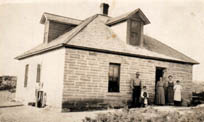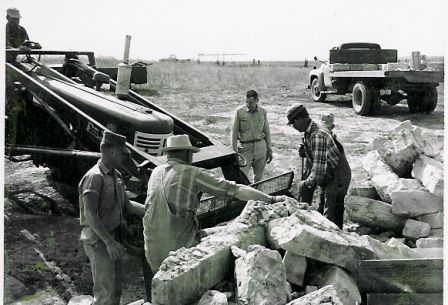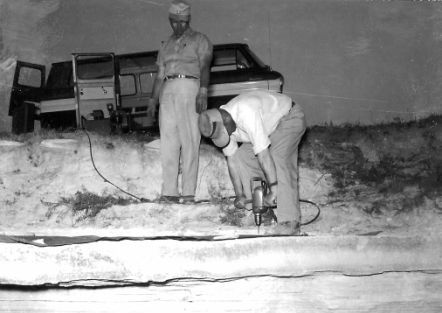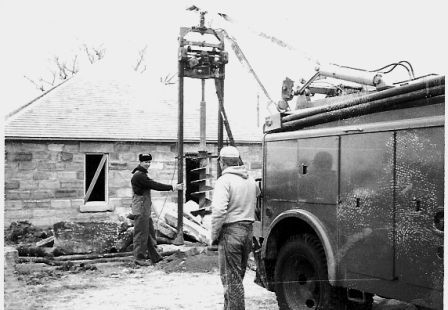The Post Rock Museum
A Museum for Post Rock

The idea for the Post Rock Museum may not so much have been conceived by the citizens of Rush County, but by the curiosity of passers-by who noticed the strange stone posts that lined the highways and back roads of the county.
For years, locals noted that visitors to Rush County often had questions about these peculiar “monuments” made of stone. Mrs. Alma Vaughn, curator of the museum for many years, once told the story of a woman who was passing through and commented, “every place has a different way of doing things, but this is the first place I've ever been that has its cemeteries beside the highways.”
Bill Appel, longtime LaCrosse barber, also fielded numerous questions about the limestone posts from his customers. Appel decided that something needed to be done. Before long, he had captured the interest of Harry Grass, president of the Farmers and Merchants State Bank, Roy Ehly, local manager of the Southwestern Bell Telephone Co. office, and others in the community. After a little “barber shop talk” and $100 seed money from Appel, the group agreed it was time to come up with a more formal way to tell the story of Post Rock - a museum.
To give the project a governing structure, the group reactivated the Rush County Historical Society. The society had originally been organized in March, 1960 for the purpose of promoting a county observance of the Kansas centennial celebration, but had become inactive at the conclusion of the festivities. In 1962, the society was reactivated, this time with plans to develop a museum to preserve the history and tell the story of Post Rock. The first officers of the society were chosen with Roy Ehly as president; Oliver Wilhelm, vice-president; Harry Grass, secretary, and Stan Merrill, treasurer. Starting with donations of just over $7,500 and a strong will to succeed, the group went to work.
The first task was to determine a location for the new museum. The site selected was a parcel of ground located in southwest LaCrosse now known as Grass Park. The park was originally donated to the town by the family of Harry Grass, Sr. and named in his honor in 1956. Grass was a prominent local citizen who had contributed much to Rush County in the early twentieth century including serving as president of the Farmers and Merchants State Bank, and representative to the Kansas Legislature. Harry Grass, Sr. was also grandfather of Harry Grass III, the society's secretary. Later additions to the park were donated by David Clymer, Mildred Brandt and family, John Luft, and Joe Herrman. Once the grounds were cleared of long overgrown brush and other debris, its traversing stream and numerous shade trees created an ideal setting for picnics and family outings and the perfect site for the new museum.
 To house the museum, the Society chose a old native stone house that stood on a homestead southwest of Nekoma, Kansas. The house was originally constructed about
1883 by Dan Haley. Stone by stone, the house was carefully dismantled, moved to LaCrosse, and reassembled on the south edge of Grass Park.
To house the museum, the Society chose a old native stone house that stood on a homestead southwest of Nekoma, Kansas. The house was originally constructed about
1883 by Dan Haley. Stone by stone, the house was carefully dismantled, moved to LaCrosse, and reassembled on the south edge of Grass Park.
To develop exhibits, the group consulted Myrl V. Walker, director of the museum at Fort Hays Kansas State College. Not only was the museum geared toward attracting and educating tourists, the intent was, according to Grass, “to preserve what is rapidly disappearing.” The centerpiece of the museum was to be a diorama of an outcropping of Greenhorn limestone with a partially quarried fence post bed exposed. The museum also was to include an assortment of artifacts composed of and related to post rock.
To further tell the story and to enhance the building, various artifacts were placed on the museum grounds. A fence of post rock and split rail provided a frame for the stone house and a wooden windmill supported by post rocks. A flagstone walkway, watering troughs, hitching posts, well covers, and tombstones made from post rock illustrate both the versatility of this stone and the ingenuity of the pioneers.
Through donations of time, labor and money from citizens of Rush County, the plan was fulfilled and the Post Rock Museum was officially dedicated May 17, 1964. At the conclusion of his address that day, Merl Walker dedicated the museum “to a single feature, a stone fence post, whose presence here in western Kansas never fails to impress the distant visitor, and remind him that he is now in western Kansas, The Land of the Post Rock, the place of the stone fence posts.”
 |
Clearing the site |
 |
The Old House |
 | Workers moving the stones |
 |
Quarrying Stone for the Diorama |
 |
Building the museum. |
 |
The finished building in 1964 |
Since its inception, the museum has contributed substantially to the economy of LaCrosse. During its first year of operation in 1964, more than 7,500 persons were registered representing 44 states and eight countries. The museum has been featured in countless books, magazines, and newspapers including a story in the July 12, 1964 issue of “ The New York Times.”
By the 1980s, the society board realized that more room was needed to store the growing collections in the museum. A storeroom and staff rest room were added to the west side of the museum. In keeping with the character of the building, the addition was constructed of Post Rock limestone and when finished blended perfectly with its century old counterpart.
During the winter season of 2006, the museum underwent a moderate facelift. The aging windmill perched behind the museum was suffering from the ravages of time. Damaged wood parts were carefully restored in exacting detail. A new wood shingle roof on the building replaced one that suffered extensive damage from a summer 2005 hailstorm.
Inside, volunteers reorganized displays and updated labels. As new items had been added to the collection over the years, cases had become crowded and there were some duplications. Displays were rearranged and categorized. Duplicate artifacts were placed into archival storage. Old style, faded labels were replaced with new ones that were easier to read and enhanced with graphics. Nevertheless, care was taken to ensure the museum retains its original look and character.
In December 2006, a more extensive modernization project was begun. Community volunteers and society members carefully removed specimens from display and placed them into temporary storage. The interior of the building was cleaned and repainted and lighting was updated. Original photographs and deteriorating manuscripts were digitally scanned and placed into archival storage. Hi-resolution copies of the originals were placed in easy-to-read reference books. In February 2007, students and faculty from Fort Hays State University’s Department of Geosciences helped to re-catalog and verify identification of all specimens. Specimens were then placed back on display with new easy-to-read labels and additional explanatory text. The historical society believes that the improvements will provide a clearer understanding of the history of the land of the Post Rock while preserving the vision of the museum’s founders.
The Post Rock Museum was only a beginning to what has become an historical complex in the town of LaCrosse. Over the years, the lone stone house has been joined by a depot, a museum for barbed wire, a bank, and a one-room school. Each is dedicated to tell its own unique story about the settlement of this important part of our country.